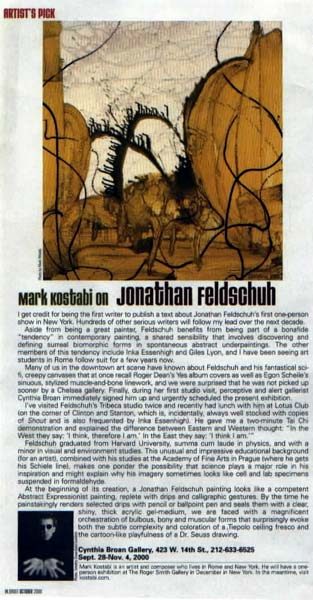Mark Kostabi on Jonathan Feldschuh

I get credit for being the first writer to publish a text about Jonathan Feldschuh’s first one-person show in New York. Hundreds of other serious writers will follow my lead over the next decade.
Aside from being a great painter, Feldschuh benefits from being part of a bonafide “tendency” in contemporary painting, a shared sensibility that involves discovering and defining surreal biomorphic forms in spontaneous abstract underpaintings. The other members of this tendency include Inka Essenhigh and Giles Lyon, and I have been seeing art students in Rome follow suit for a few years now.
Many of us in the downtown art scene have known about Feldschuh and his fantastical sci-fi, creepy canvases that at once recall Roger Dean’s Yes album covers as well as Ego Scheile’s sinuous, stylized muscle-and-bone linework, and we were surprised that he was not picked up sooner by a Chelsea gallery. Finally, during her first studio visit, perceptive and alert gallerist Cynthia Broan immediately signed him up and urgently scheduled the present exhibition.
I’ve visited Feldschuh’s Tribeca studio twice and recently had lunch with him at Lotus Club (on the corner of Clinton and Stanton, which is, incidentally, always well stocked with copies of Shout and is also frequented by Inka Essenhigh). He gave me a two-minute Tai Chi demonstration and explained the difference between Eastern and Western thought: “In the West they say: ‘I think, therefore I am.’ In the East they say: ‘I think I am.’”
Feldschuh graduated from Harvard University, summa cum laude in physics, and with a minor in Visual and environment studies. This unusual and impressive educational background (for an artist), combined with his studies at the Academy of Fine Arts in Prague (where he gets his Schiele line), makes one ponder the possibility that science plays a major role in his inspiration and might explain why his imagery sometimes looks like cell and lab specimens suspended in formaldehyde.
At the beginning of its creation, a Jonathan Feldschuh painting looks like a competent Abstract Expressionist painting, replete with drips and calligraphic gestures. By the time he painstakingly renders selected drips with pencil or ballpoint pen an seals them with a clear, shiny, thick acrylic gel-medium, we are faced with a magnificent orchestration of bulbous, bony and muscular forms that surprisingly evoke both the subtle complexity and coloration of a Tiepolo ceiling fresco and the cartoon-like playfulness of a Dr. Seuss drawing.
October 2000